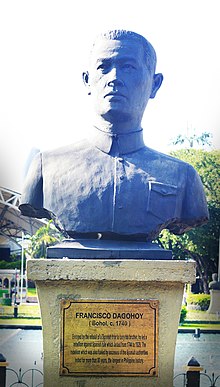|
Dagohoy rebellion
 The Dagohoy rebellion, also known as the Dagohoy revolution and the Dagohoy revolt, is considered as the longest rebellion in Philippine history. Led by Francisco Dagohoy, or Francisco Sendrijas, the rebellion took place on the island of Bohol from 1744 to 1800,[2] lasting for roughly 56 years. It was one of two significant revolts that occurred in Bohol during the Spanish era. The other one was the Tamblot uprising in 1621 led by Tamblot, a babaylan or native priest from Bohol which was basically a religious conflict.[3] Legacy The Dagohoy rebellion features in the Bohol provincial flag as one of the two Sundang or native swords with handle and hand-guards on top. These two sundang, which are reclining respectively towards the left and right, depict the Dagohoy and Tamblot revolts, symbolizing that "a true Boholano will rise and fight if supervening factors embroil them into something beyond reason or tolerance."[4] The town of Dagohoy, Bohol is named in his honor. It was Vice President Carlos P. Garcia who proposed the name "Dagohoy" in honor of Francisco Sendrijas alias Dagohoy. The name Dagohoy is a concatenation of the Visayan phrase Dagon sa huyuhoy or "talisman of the breeze" in English.[5] The Dagohoy Memorial National High School in Dagohoy, Bohol is also named in his honor and memory. References
Related Literature
External links
|
||||||||||||||||||||||||||||
Portal di Ensiklopedia Dunia